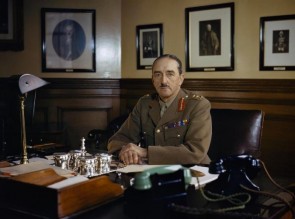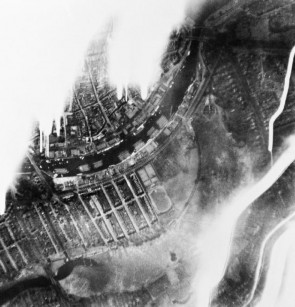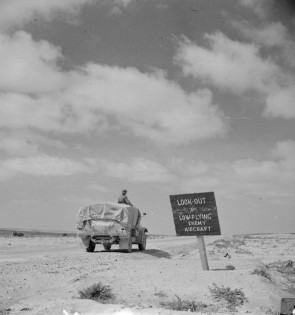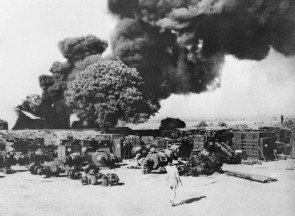You are currently browsing the monthly archive for March 2012.
14 ships from Allied convoy PQ13 arrive safely at Murmansk today and tomorrow, but 5 ships have been sunk by coordinated German action (2 by U-boats, 2 by aircraft, 1 by a surface vessel).
U-boats swarm around the scattered ships of convoy PQ13 in the Barents Sea 100 miles North of Murmansk, USSR. At 5.52 AM, U-209 misses British SS Induna with 2 torpedoes but U-376 sinks SS Induna at 8.07 AM (38 killed, 28 survivors in 2 lifeboats picked up by a Russian minesweeper on April 2). At 10.35 AM, a torpedo from U-456 stops American SS Effingham (2 drowned, 41 crew and gunners escape in 2 lifeboats), which is then sunk by U-435 at 12.19 PM. 1 lifeboat is found next day by British minesweeper HMS Harrier (17 men alive, 6 died of exposure). The other lifeboat is found on April 1 by a Soviet patrol vessel (14 men alive, 4 died of exposure). Many of the survivors from SS Induna and SS Effingham will lose limbs to frostbite, having been sprayed by icy water in temperatures of 20° below zero. U-585 is heading from Kirkenes (after repairs from depth charge damage on March 24) to join the hunt but sinks 72 miles North of Murmansk on a German mine which had drifted from the ´Bantos-A´ barrage (all 44 hands lost).
Battle of Convoy PQ13, in the Barents Sea 230 miles North of Murmansk, USSR. At 9.43 AM, British cruiser HMS Trinidad spots German destroyers Z-24, Z-25 and Z-26 on radar and immediately opens fire, hitting Z-26 numerous times. At 10.24 AM, HMS Trinidad fires a torpedo which becomes a circle runner and hits HMS Trinidad underneath the bridge (31 killed, temporary repairs in Murmansk until May 13). At 10.32 AM, British destroyer HMS Eclipse takes over the attack, hitting Z-26 with 6 more 4.7-inch shells. At 11.20 AM, Z-24 and Z-25 attack HMS Eclipse scoring 2 hits with 5-inch shells (23 killed, temporary repairs in Murmansk until April 6). Z-26 finally sinks (240 men die in the freezing water, 96 survivors rescued by Z-24 and Z-25).
Operation Chariot. At 1.22 AM British destroyer HMS Campbeltown enters the Loire estuary along with motor launches carrying Commandos plus 1 MTB and 1 MGB. They are illuminated with searchlights and fired on by German shore batteries, sinking many of the small vessels. Despite being hit a number of times, HMS Campbeltown rams the gates of the dry dock at 1.34 AM. Commandos on HMS Campbeltown and from the surviving launches go ashore to destroy pumping machinery and other dock installations. The MTB torpedoes the closed gate to the main marina (Basin de St Nazaire). Only 228 men return to England, 105 Royal Navy personnel & 64 Commandos are killed and another 106 sailors and 109 Commandos are taken prisoner by the Germans (5 VCs are awarded for the raid). A timer detonates the explosives on HMS Campbeltown at noon, killing 40 German officers and civilian administrators touring the ship plus 320 others nearby. The dry dock is flooded and put out of service for the rest of the war.
Operation Chariot. At 1.22 AM British destroyer HMS Campbeltown enters the Loire estuary along with motor launches carrying Commandos plus 1 MTB and 1 MGB. They are illuminated with searchlights and fired on by German shore batteries, sinking many of the small vessels. Despite being hit a number of times, HMS Campbeltown rams the gates of the dry dock at 1.34 AM. Commandos on HMS Campbeltown and from the surviving launches go ashore to destroy pumping machinery and other dock installations. The MTB torpedoes the closed gate to the main marina (Basin de St Nazaire). Only 228 men return to England, 105 Royal Navy personnel & 64 Commandos are killed and another 106 sailors and 109 Commandos are taken prisoner by the Germans (5 VCs are awarded for the raid). A timer detonates the explosives on HMS Campbeltown at noon, killing 40 German officers and civilian administrators touring the ship plus 320 others nearby. The dry dock is flooded and put out of service for the rest of the war.
News of the terms Cripps took to India supposed to be bursting tomorrow. Meanwhile only rumours, all plausible but completely incompatible with one another. The best-supported – that India is to be offered a treaty similar to the Egyptian one. K.S.S [1] who is our fairly embittered enemy, considers this would be accepted if Indians were given the Ministries of Defence, Finance and Internal Affairs. All the Indians here, after a week or two of gloom, much more optimistic, seeming to have smelt out somehow (perhaps by studying long faces in the India Office) that the terms are not so bad after all
Overnight, 24,000 pounds of frozen water buffalo meat is loaded onto a barge and ferried from Corregidor to Bataan. Japanese bombing prevents unloading during the day and by nightfall the meat has spoiled. It is unloaded and buried by the local Quartermaster.
British destroyer HMS Jaguar and anti-submarine whaler HMS Klo and Greek destroyer RHS Vasilissa Olga escort British fleet oiler Slavol bringing fuel to Tobruk for the 5th Destroyer Flotilla. At 2.27 AM 20 miles off Sidi Barani, Egypt, U-652 sinks HMS Jaguar (193 killed, 53 survivors picked up by HMS Klo while RHS Vasilissa Olga assists). U-205 takes advantage of the confusion and sinks the unescorted Slavol at 5.10 AM (36 killed, 20 survivors rescued by RHS Vasilissa Olga).
Admiral Ernest King (Commander in Chief, United States Fleet and Chief of Naval Operations) plans to garrison the islands between Hawaii and Australia as staging posts to counter Japanese expansion in the South Pacific threatening Australia. US 162nd Infantry Regiment (41st Division) arrives to establish a refueling base at Bora-Bora in the French Society Islands (2500 miles South of Hawaii and 4150 miles East of Australia). A Marine brigade had already arrived in the Samoan Islands (2900 miles East of Australia) on March 20.
At 3 AM 365 miles North of Bermuda, U-123 attacks British tanker MV Empire Steel with torpedoes and the deck gun. Empire Steel, carrying 11,000 tons of aviation spirit and kerosene from the Gulf of Mexico to Britain, explodes and sinks (35 crew and 4 gunners lost, 7 crew and 1 gunner picked up by American tug Edmund J. Moran and landed at Norfolk, Virginia).
In the aftermath of 2nd Battle of Sirte, convoy MW10 does not arrive at Malta overnight as planned and is still at sea at daybreak. The 4 British transport ships are attacked by German bombers, sinking Clan Campbell and badly damaging Breconshire (which is beached). British destroyer HMS Southwold hits a mine and sinks (6 killed, 80 survivors rescued by destroyer HMS Dulverton) while assisting Breconshire. Freighters Pampas and Talabot reach Malta and begin unloading their cargo.











